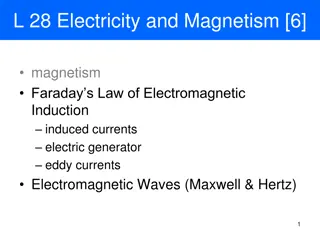Exploring Magnetism: Properties, Differences, and Similarities
Discover the properties of magnets and magnetic materials, understand the differences and similarities between permanent magnets and electromagnets. Delve into the basics of magnetism, explore magnetism stations, hypothesize about magnetic attraction, and learn interesting facts about magnets. Engage with visual content and hands-on experiments to deepen your understanding of this fascinating force.
Download Presentation

Please find below an Image/Link to download the presentation.
The content on the website is provided AS IS for your information and personal use only. It may not be sold, licensed, or shared on other websites without obtaining consent from the author. Download presentation by click this link. If you encounter any issues during the download, it is possible that the publisher has removed the file from their server.
E N D
Presentation Transcript
MAGNETISM Essential Question: What are properties of magnets & magnetic materials? How is a perma-magnet different from (and similar to) an electromagnet?
Magnetism Stations The stations in the back of the room are set up so that you can explore magnetism! Please take the time to read aloud the procedures/questions for the lab.
MAGNETISM EXPLAINED Need more info? Try these videos Magnetism for Kids Beginner Bill Nye: Magnetism Intermediate Khan Academy: Magnetism Advanced
Hypothesize: Which of the following items will a magnet attract? Yes Item No Pencil Paper Clip Penny Marble Scissors Nuts & Bolts Screw Button
Check your work Item Yes No Pencil Paper Clip Penny Marble Scissors Nuts & Bolts Screw Button
What do these items have in common? They are made of iron, cobalt, or nickel (or a mixture). These materials are magnetic.
What is Magnetism? Magnetism is a force (like gravity) and a form of energy It is the force of attraction or repulsion of a magnetic material due to the arrangement of its electrons. Magnetism was discovered by the Greeks. (They found a mineral called magnetite that attracted some metals to it) This mineral (a magnet) can be used to see the effects of magnetism.
Facts About MAGNETS
The ends of a magnet are where the magnetic effect is the strongest. These are called poles. Each magnet has 2 poles 1 north, 1 south.
The Law of Attraction Like poles repel repel Opposite poles attract attract!
Poles of a magnet always come in pairs!
If you cut a magnet in half, N S N S you get 2 magnets!
Magnetic Fields The region where the magnetic forces act is called the magnetic field
The Earth is a magnet: Earth s magnetic field is mostly caused by electric currents in the liquid outer core which is composed of conductive, molten iron. Food for Thought: the north end of a compass magnet is drawn to align with the Earth's magnetic field. Because the Earth's magnetic North Pole attracts the "north" ends of other magnets, it is technically the "South Pole" of our planet's magnetic field.
There are 2 types of magnets: Permanent magnets permanent Keep their magnetism all of the time Ex. Refrigerator magnet Electromagnets Temporary Can be magnetized by running electricity through it Ex. Car alternator
Electromagnets By running electric current through a wire, you can create a magnetic field. By using this simple principle, you can create all sorts of things, including motors, speakers, disk drives and so on.
Electromagnets Once an electromagnet is made, the magnetic field can be made stronger. To increase the strength of the magnetic field, you must increase the number of coils/loops in the conductive wire.
Electromagnets Electromagnets can also be made stronger by: 1) increasing the number of coils 2) increasing the thickness of the wire 3) increasing the size of the metal rod that the wire is wrapped around. 4) increasing the battery size























